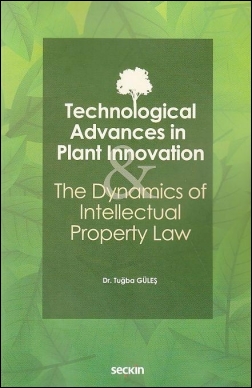Technological Advances in Plant Innovationthe Dynamics of Intellectual Property Law

"Many observers refer to today's global economy as one in transited to a ‘knowledge economy' and en route to the knowledge-based Bio-Economy. Rapid transition to a knowledge-based bioeconomy has significant implications for range of issues critical to the sustainability of agriculture, eco-systems and economic growth. Hence, potentials of plants as a technology platform is increasingly being explored so are the socio-ecological impacts.
Today's plant biotechnology industry produces intellectual property as its manufactured goods and advances in biological sciences raised the private value of the plant genetic resources. However, much uncertainty remains about the ability to adopt the existing Intellectual Property framework to changed circumstances of post 19th century. This uncertainty raises questions into both the limitations of technology neutral principles of the patent system and the effectiveness of industry specific modifications.
This book provides legal scholars, attorneys, industry representatives, law reformers, and legislative advocates with a more nuanced and comprehensive understanding of the Intellectual Property law framework for plant innovation. The book also offers new understanding of the relationship between patent and plant variety protection system, as well as the two systems' strengths and limitations in terms of their implications on innovative activity." (Arka Kapak Yazısı)
Konu Başlıkları
- Trajectory of Developments in Plant Innovation and IP Protection
- Existing IP Law Framework for Plant Innovation
- Key Legal Challenges and Responses
- Açıklama
"Many observers refer to today's global economy as one in transited to a ‘knowledge economy' and en route to the knowledge-based Bio-Economy. Rapid transition to a knowledge-based bioeconomy has significant implications for range of issues critical to the sustainability of agriculture, eco-systems and economic growth. Hence, potentials of plants as a technology platform is increasingly being explored so are the socio-ecological impacts.
Today's plant biotechnology industry produces intellectual property as its manufactured goods and advances in biological sciences raised the private value of the plant genetic resources. However, much uncertainty remains about the ability to adopt the existing Intellectual Property framework to changed circumstances of post 19th century. This uncertainty raises questions into both the limitations of technology neutral principles of the patent system and the effectiveness of industry specific modifications.
This book provides legal scholars, attorneys, industry representatives, law reformers, and legislative advocates with a more nuanced and comprehensive understanding of the Intellectual Property law framework for plant innovation. The book also offers new understanding of the relationship between patent and plant variety protection system, as well as the two systems' strengths and limitations in terms of their implications on innovative activity." (Arka Kapak Yazısı)
Konu Başlıkları- Trajectory of Developments in Plant Innovation and IP Protection
- Existing IP Law Framework for Plant Innovation
- Key Legal Challenges and Responses
İÇİNDEKİLERTable of ContentsAcknowledgements 7Abstract 9List of Figures and Tables 15Table of Authorities 17List of Acronyms and Abbreviations 23Definitions of Central Terms 25INTRODUCTION 31i. Background of the Research 31ii. Research Objectives 44iii. Methodology and Structure 471. Chapter I 482. Chapter II 493. Chapter III 50iv. Sources 50CHAPTER ITrajectory of Developments in Plant Innovation andIP ProtectionA. Trajectory of Developments in Plant Innovation 51i. The Key Characteristics of Plant Innovation 521. Cumulative 532. Path Dependent 543. Sequential 55ii. Paradigm of Phenotype 55iii. Paradigm Shift from Phenotype to Genotype 58iv. Molecular Breeding Era 61v. Nanoscale Breeding and Plants as Genetic Datasets 70B. Trajectory of Developments in IP Protection 73i. Institutional Shifts in Plant Breeding 73ii. Advent of Plant Variety Protection 78iii. Advent of Patent Protection 84CHAPTER IIExisting IP Law Framework for Plant InnovationA. Key Differences between Plant Variety Protection and Patent Protection 87i. Farmers as User–innovators and Farm–saved Seed Exemption 91ii. Comparative Analysis of Farm–saved Seed Exemption 98iii. Breeder’s Exemption and Essentially Derived Variety 108B. Intellectual Property Protection for Plant Innovation: Comparative Analysis 112i. Liberal Approach 114Australia 114Japan 116South Korea 117United States 118ii. Modified Approach 119Canada 119European Union 119iii. Minimum Standards Provided by TRIPs 121Argentina 122Brazil 122China 123India 123Mexico 124Main Findings 124C. Trends in Intellectual Property Protection for Plant Innovation 125i. Trends in Patent Protection 125ii. Trends in UPOV Model Plant Variety Protection 134D. Empirical Analysis of the Incentive Effects of IP Protection 140i. Incentive Effects on Agricultural Productivity Growth, Private Investment and R&D 141ii. Incentive Effects on Foreign Direct Investment and Trade 155Main Findings 161CHAPTER IIIKey Legal Challenges and ResponsesA. Patent Law: Doctrinal Difficulties and Fluxes in the Formulations 163i. Reconfiguration of the Invention 169ii. Revisiting ‘Products of Nature’ Doctrine in the Biotech Era 173iii. Distinguishing the ‘Essentially’ Biological Process in the Biotech Era 182iv. Preion for the Product of Nature Doctrine: isolating and replicating natural to produce ‘unnatural’ 188v. Anything Under the Sun Made by Man that is ‘Markedly Different’ 194B. Co–Existence of PVP System and Patent Protection 202i. Distinction between overlapping protection and premise of mutual exclusiveness 202ii. De facto Overlaps between Patent and Plant Variety Protection Systems 206Conclusion 211Bibliography 235Stok Kodu:9789750249280Boyut:16x23,5Sayfa Sayısı:276Basım Yeri:AnkaraBaskı:1Basım Tarihi:2018 TEMMUZKapak Türü:Karton KapakKağıt Türü:1. HamurDili:Türkçe
















